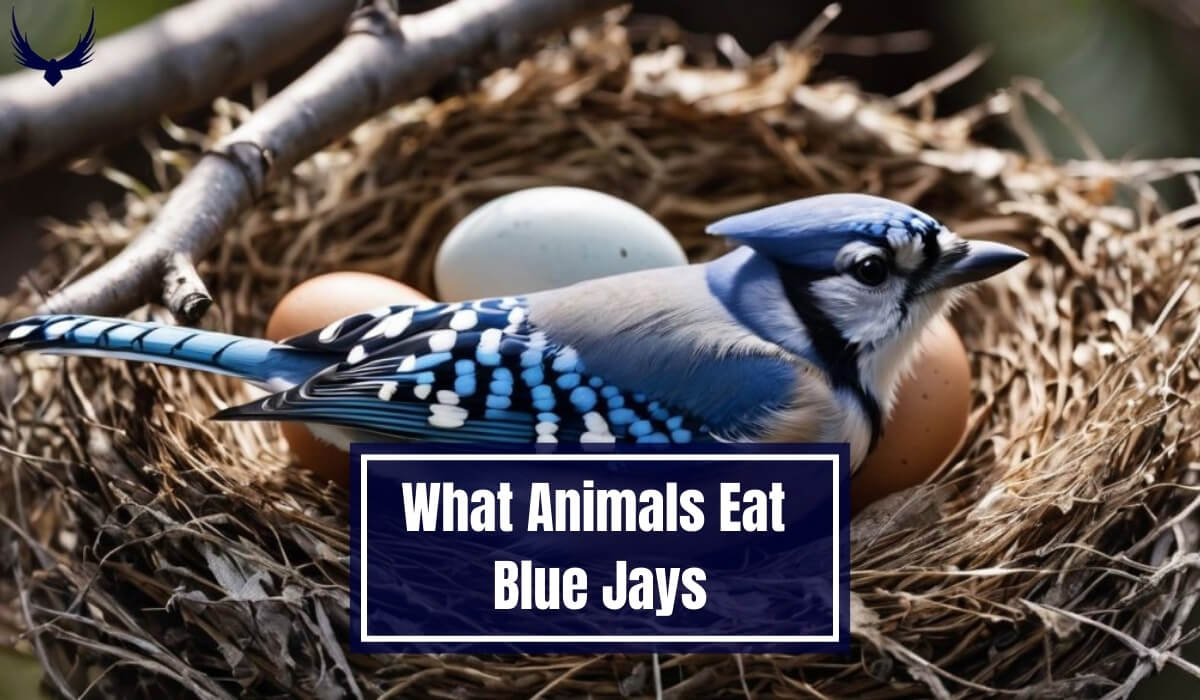Have you ever wondered what Blue Jay eggs look like or how they hatch? Blue Jays are beautiful birds found in many parts of North America. Their eggs are just as interesting as the birds themselves!
In this article, we’ll explore the Blue Jay eggs color, size, and appearance. We’ll also learn about the exciting process of how these eggs hatch into baby Blue Jays.
What Color are Blue Jay Eggs?
Blue jay eggs are light blue or bluish green in color, with brown or gray spots scattered across the shell. The color of blue jay eggs helps to camouflage the eggs in the nest, protecting them from predators.

The blue tint comes from a pigment called biliverdin, which is deposited on the eggshell as it forms inside the female blue jay. The intensity of the bluejay egg color can vary somewhat between different eggs, even within the same clutch.
How Big are Blue Jay Eggs?
Blue jay eggs are small, measuring about 1 inch (2.5 cm) in length and 0.8 inches (2 cm) in width. They are oval-shaped and about the size of a quarter or a large grape. Despite the blue jay being a medium-sized bird, their eggs are not much bigger than those of smaller songbirds.
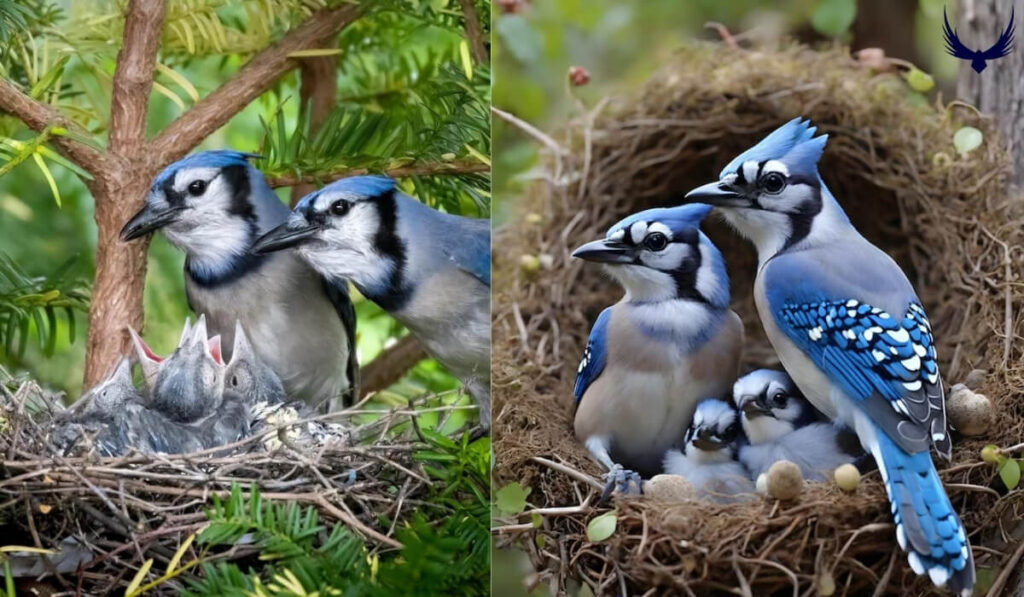
This size allows the female blue jay to lay and incubate multiple eggs in her nest, which is built in tree branches. The compact size of the eggs also helps them retain heat efficiently during incubation.
What do Blue Jay Eggs Look Like?
Bluejay eggs are small and oval-shaped, about the size of a quarter. They have a light blue or bluish green base color. The eggs are speckled with brown or gray spots, creating a mottled appearance.
These spots are more concentrated at the larger end of the egg. The combination of the blue background and darker speckles helps the eggs blend in with their surroundings in the nest.
How Many Eggs Does a Blue Jay Lay?
A blue jay lays between 3 to 6 eggs in a single clutch. The most common number is 4 or 5 eggs. The female blue jay lays one egg per day until the clutch is complete. This strategy helps ensure that all the eggs will hatch around the same time.
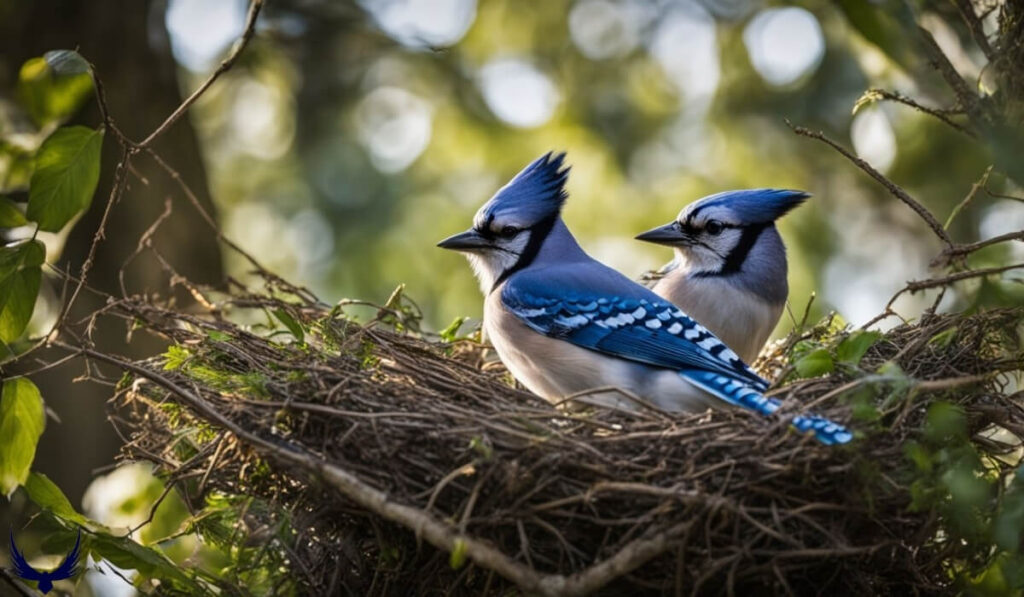
Blue jays have only one or two broods per year, meaning they lay eggs once or twice during the breeding season. The number of eggs can vary slightly depending on factors such as the age and health of the female as well as environmental conditions.
Where do Blue Jays Lay Egg?
Blue Jays lay their eggs in nests they build high up in trees that are 10 to 25 feet above the ground. They prefer to build these nests in deciduous trees like oaks or maples but may also use evergreens.
The nest is cup-shaped, made from twigs, bark, roots, and leaves, and lined with softer materials like grass or feathers. Blue Jays often choose a spot where branches fork, providing a sturdy base for their nest.
What Month do Blue Jays Lay Eggs?
Blue Jays lay eggs in late spring to early summer between April and June. This timing allows the birds to take advantage of warmer weather and increased food availability for raising their young.
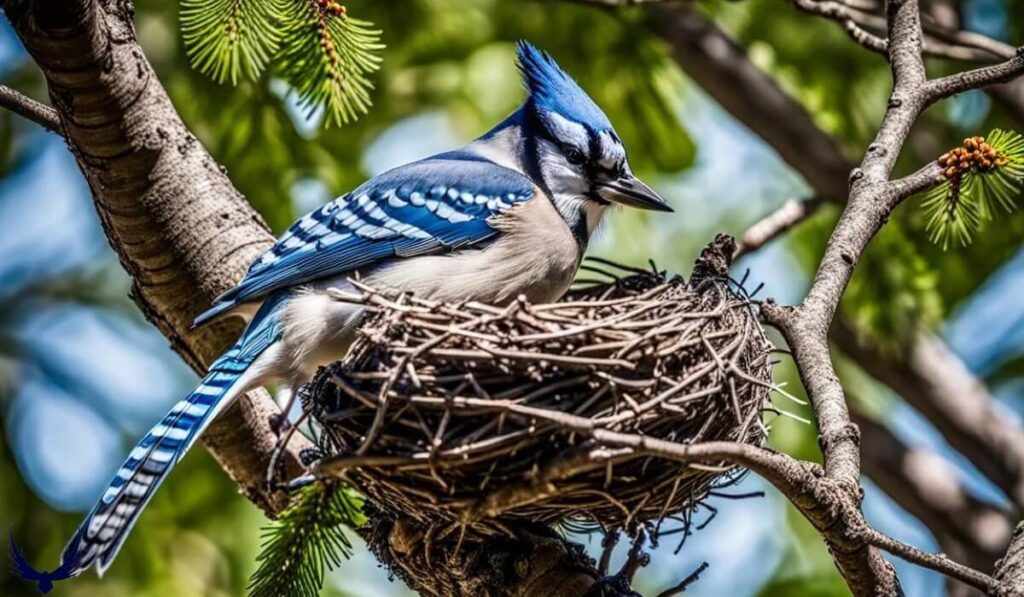
During this period, Blue Jays build nests and females lay 3 to 6 eggs, which they incubate for about 16 to 18 days before the chicks hatch.
How do Blue Jays Incubate Eggs?
Blue Jays incubate their eggs naturally in nests they build in trees. The female Blue Jay does most of the incubation, sitting on the eggs to keep them warm for about 16 to 18 days.
She turns the eggs periodically to ensure even heating and proper development of the embryos. During this time, the male Blue Jay often brings food to the female and helps guard the nest to protect the eggs from predators.
How Long Does It Take for Blue Jay Eggs to Hatch?
Blue jay eggs hatching takes about 16 to 18 days after the female finishes laying all the eggs in her clutch. During this time, the female blue jay incubates the eggs, keeping them warm and turning them regularly to ensure even development of the embryos inside.
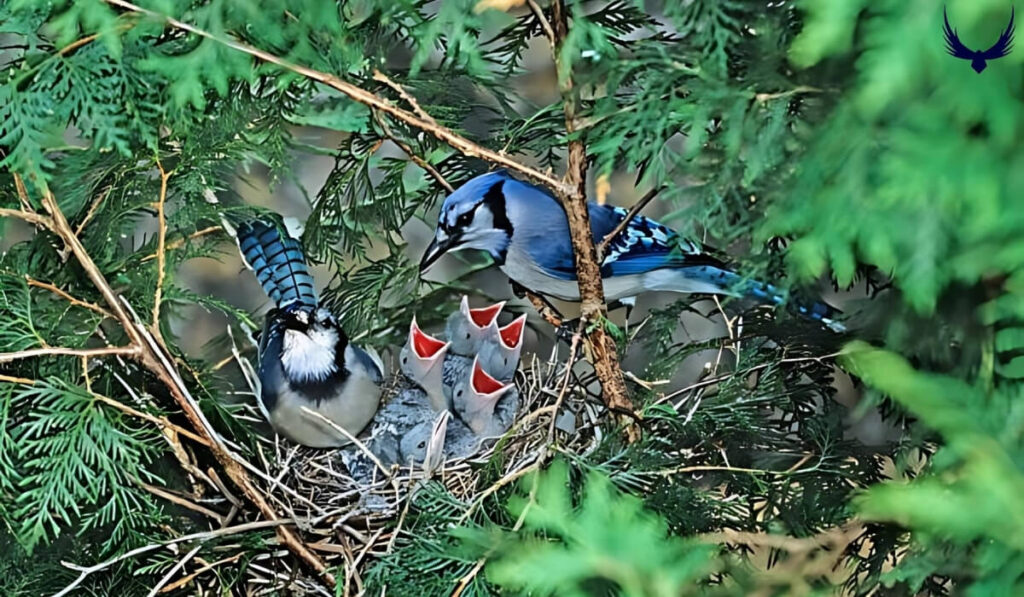
The male blue jay brings food to the female while she sits on the nest. Towards the end of the incubation period, the eggs may begin to show small cracks as the chicks inside prepare to emerge. All the eggs in a clutch hatch within a day or two of each other.
Blue Jay Eggs Vs Robin Eggs
Blue Jay eggs and Robin eggs have several key differences. Bluejay eggs are slightly larger. Blue Jay Eggs size is about 1 to 1.3 inches long, while Robin eggs are around 1.1 to 1.2 inches.
Blue Jays egg can be light blue or bluish green with brown or cream spots, while Robin eggs are famously a solid blue color, sometimes with light brown speckles.
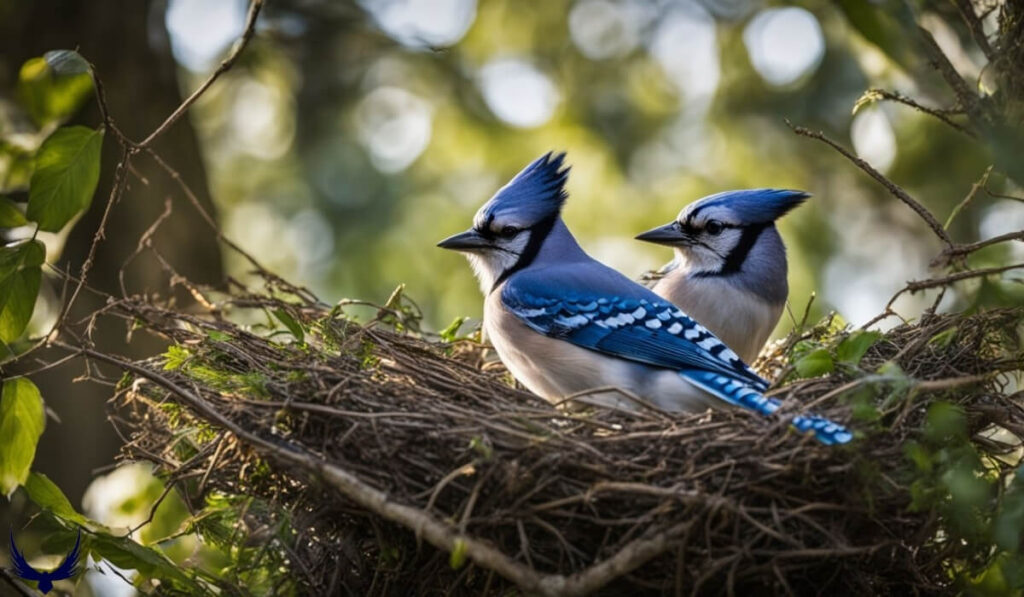
Blue Jays lay 3 to 6 eggs per clutch, while Robins lay 5 to 6. The incubation period is longer for Blue Jays at 17 to 18 days, compared to 12 to 14 days for Robins.
Blue Jays build their nests where tree branches meet the trunk, while Robins often nest in various locations including trees, shrubs, and man-made structures. Both species build cup-shaped nests, but Blue Jays prefer higher locations in trees.
Robin chicks leave the nest after about 13 days, but Blue Jay chicks stay for 17 to 21 days.
How do Blue Jays Take Care of their Eggs?
Female Blue Jays take care of their eggs by spending most of their time sitting on the eggs to keep them warm. She turns the eggs regularly to ensure they develop evenly. The male brings food to the female and guards the nest from threats.
Both parents are very protective and will aggressively defend their nest and eggs from predators or intruders, often making loud calls to warn off danger.
Why do Blue Jays Eat Egg Shells?
Blue Jays eat eggshells as a source of calcium, which is essential for their health. After their chick’s hatch, blue jays often consume the leftover eggshells from their own nest. This behavior helps them replenish the calcium they lost during egg production and incubation.
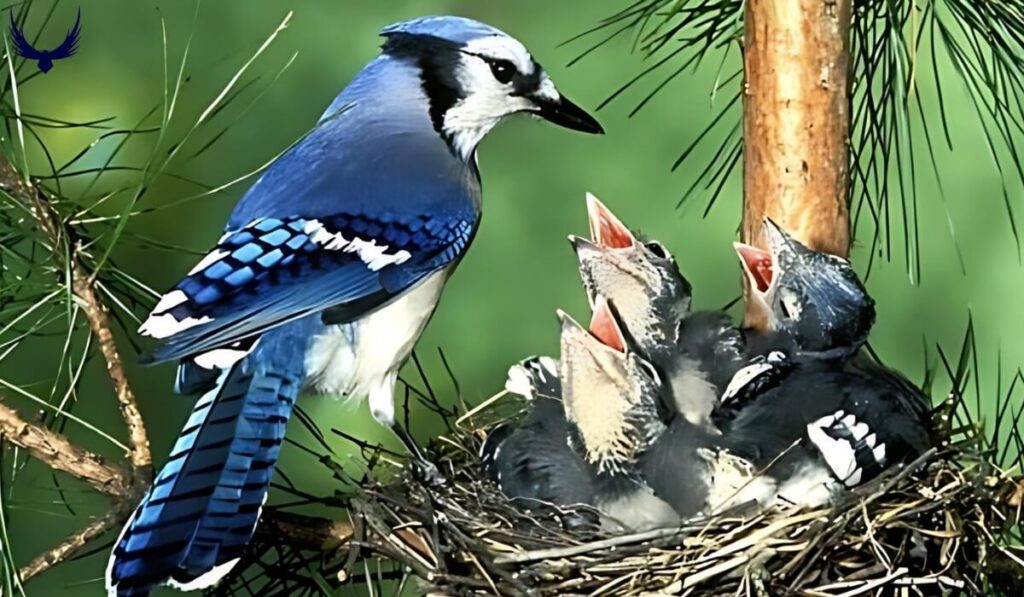
Calcium is crucial for adult blue jays to maintain strong bones and produce eggs with sturdy shells. It’s also important for the growth of their chicks. By eating eggshells, blue jays efficiently recycle this valuable nutrient.
FAQs – Blue Jay Eggs
When do Blue Jay Eggs Hatch?
Blue Jay eggs hatch after an incubation period of 16 to 18 days. This occurs in late spring or early summer, about two to three weeks after the eggs are laid. The timing can vary slightly depending on factors like weather and the specific location, but Blue Jay chicks emerge from their eggs between mid-May and early July.
How to Incubate Blue Jay Eggs?
To incubate Blue Jays egg, you would need a specialized incubator set to maintain a temperature of about 37 to 38°C and humidity around 50 to 60%. The eggs should be turned gently several times a day to prevent the embryo from sticking to the shell. Incubation lasts 16 to 18 days.
How to Take Care of a Blue Jay Egg?
Taking care of a blue jay egg is best left to the parent birds. If you find an egg, it’s important to leave it where it is, as moving it can be harmful. Blue jay eggs need consistent warmth and proper turning, which the mother provides. If the egg is truly abandoned or in danger, contact a licensed wildlife rehabilitator for guidance on proper care and incubation techniques.
Are Blue Jay Eggs for Sale?
It’s not legal to buy or sell blue jay eggs in most places. Blue jays are protected under laws that prohibit taking or selling their eggs. Instead, people can enjoy watching blue jays and other wild birds in nature without disturbing their nests or eggs.

